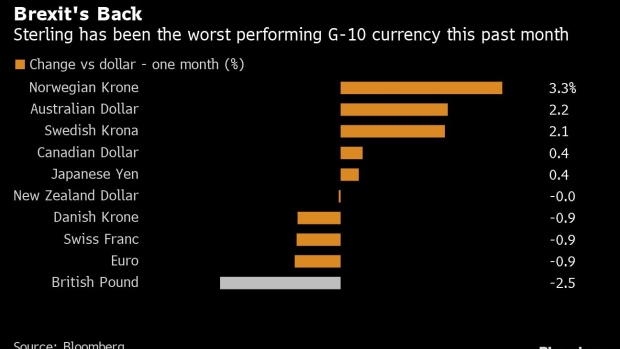May 15, 2020
British Pound Becomes Pariah of World Currencies
, Bloomberg News

(Bloomberg) --
The pound is back to being the pariah of the currency world as renewed Brexit risks worsen the troubles of a market still reeling from the shock of the pandemic.
Sterling fell a fifth day against the dollar on Friday after the latest negotiations between the U.K. and the European Union seemed set for a stalemate, with both sides refusing to compromise on key issues such as trade and movement of citizens. The pound is already the past month’s worst-performing Group-of-10 currency and options signal more pain ahead.
British Prime Minister Boris Johnson threatened to walk away from the talks this week if enough progress wasn’t made. That raises the risk that the U.K. will end its transition period on Dec. 31 without a free-trade deal -- putting further strain on an economy that’s already facing the worst recession in three centuries.
“Brexit has reared its head again,” said Ned Rumpeltin, the European head of currency strategy at Toronto-Dominion Bank. “After hibernating since the end of last year, it looks like Brexit isn’t quite finished as a bearish factor for sterling. G-10 currencies remain highly risk-driven against the dollar, but the return of these concerns could emerge as a significant differentiator for sterling.”
Buffeted by successive elections, failed parliamentary votes and shifts in monetary policy, volatility in sterling was at one point on par with those seen in riskier, emerging-market nations. The pound is already among the most volatile among G-10 currencies, second only to Norway’s krone this year.
The pound has fallen 1.7% this week to around $1.22, on track for the worst such decline in almost two months. A close on Friday below the $1.2166 -- a level that proved to be a key chart support in recent weeks -- could set the stage for further losses, according to Rumpeltin.
Lee Hardman, a strategist at MUFG, sees the U.K. currency slipping to $1.20 or even lower in the short term. While the consensus call in a Bloomberg currency survey is for sterling to climb 3% from current levels to end the year at $1.26, this is significantly lower than the $1.33 predicted just two months ago.
“There is an increasing risk that investors view the outlook for the U.K. more negatively relative to elsewhere, thus encouraging increased speculative selling,” MUFG’s Hardman said. “The U.K. is in the unique position of having a considerable risk on the horizon in relation to the E.U. trade negotiations.”
Two-month pound-dollar risk reversals, an options gauge of positioning that cover the June 30 deadline for any extension of a Brexit transition period, continue to signal a markedly bearish outlook for the U.K. currency.
The EU’s chief Brexit negotiator Michel Barnier is due to give a press conference Friday on this week’s round of negotiations.
“Do I expect a significant deterioration in talks at this stage? No, as there are still the June and September rounds before the hoped October “soft” deadline,” said Jordan Rochester, a currency analyst at Nomura International Plc. “But it would help focus minds if Barnier turns up the temperature. We remain short sterling.”
©2020 Bloomberg L.P.